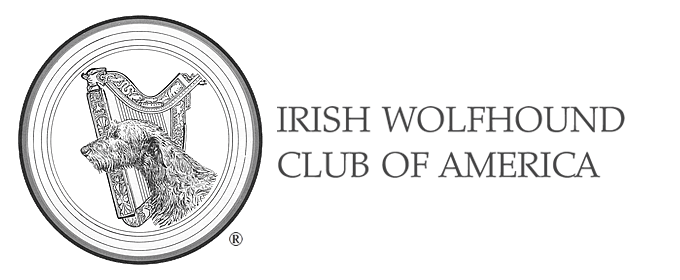The IWCA has redone the website! If you are an IWCA Member, you will need to use the Forgot Password form to reset your password.
Remember, renewals for 2026 start November 1!

The IWCA has redone the website! If you are an IWCA Member, you will need to use the Forgot Password form to reset your password.
Remember, renewals for 2026 start November 1!
William D. Tyrrell, Jr., DVM, DACVIM (Cardiology)
 Irish Wolfhound getting EKG done by volunteers with IWCA and IWF.
Irish Wolfhound getting EKG done by volunteers with IWCA and IWF.The most common form of heart disease in the Irish Wolfhound (IW) is Irish Wolfhound type Cardiomyopathy (IWCM). This disease state was formerly referred to as dilated cardiomyopathy (DCM). The IW does not often have typical DCM and cardiomyopathy better describes IW heart disease.
Greater than 99% of IWs with IWCM will have concurrent atrial fibrillation, an arrhythmia affecting the top chambers of the heart called the atria. The IW with heart disease typically has a longer survival time than breeds such as the Boxer, Doberman Pinscher, and Great Dane – breeds with classic DCM.
 This is 4 year old hound in normal sinus rhythm. Note an atrial beat (P-wave circled) is before each ventricular beat (star) and the interval between the beats is essentially equal.
This is 4 year old hound in normal sinus rhythm. Note an atrial beat (P-wave circled) is before each ventricular beat (star) and the interval between the beats is essentially equal. Atrial fibrillation in a six year old Irish Wolfhound. Note the irregular intervals between the tall spikes (ventricular beats or R-waves) and the absence of the P-wave or regular atrial beat before each complex.
Atrial fibrillation in a six year old Irish Wolfhound. Note the irregular intervals between the tall spikes (ventricular beats or R-waves) and the absence of the P-wave or regular atrial beat before each complex.
Atrial fibrillation, an arrhythmia of the heart, is characterized as a rapid, irregularly irregular heart rhythm and can be analogous to listening to sneakers in a spinning clothes dryer or jungle drums. The IW affected with atrial fibrillation is typically exercise intolerant, weak, or just “off.” The owner may note a decrease in appetite or lack of desire to go on walks. However, many hounds with afib - often those with slower heart rates - have no symptoms, which makes periodic screening for this arrhythmia even more important.
Clinical signs relating to left-sided congestive heart failure include labored or rapid breathing, coughing, and exercise intolerance. The owner may note their IW will not lie down on their side (lateral recumbency) and will sit or lie with the head upright as this position makes it easier to breathe.
The North American experience with IW cardiomyopathy is a little different than what is usually seen in other large breed dogs commonly affected with heart disease.
These findings were recently reported in the Journal of Veterinary Internal Medicine (Tyrrell et al, February 29, 2020) in a study supported by the Irish Wolfhound Foundation. The disease usually begins with the onset of atrial fibrillation. Predictive values from this data showed that in the absence of atrial fibrillation there is only a .2% chance the hound has echocardiogram abnormalities. The electrocardiogram, a.k.a., EKG or ECG, (much less expensive and more easily available) can be used as a screening test for IW heart disease.
Initially after afib is found, the heart size and function may be normal, or the left atrium may be minimally enlarged. As time and the disease progress, the left atrium becomes increasingly enlarged or dilated. The left ventricle will enlarge as well, however, not to the extent that we see in breeds with typical DCM. Additionally, the left ventricle’s systolic function or pumping ability is usually not severely depressed as in canine breeds with DCM. Right-sided congestive heart failure (fluid in the chest or belly) can uncommonly occur at an extremely late stage in the progress of IWCM.
Treatment depends on the stage of the disease. Early detection and early medical intervention have been shown to prolong the lives of IWs for years. A recent article in the Journal of Veterinary Internal Medicine (Vollmar et al, 2016) showed that IWs with preclinical heart disease that are treated with pimobendan/Vetmedin® had a significantly prolonged time to onset of congestive heart failure.
Your IW should be examined at least yearly by your veterinarian, and as they age to over four years, twice yearly examinations are recommended. An electrocardiogram (EKG/ECG) should be run on an annual basis by your veterinarian and then ideally twice yearly if your IW is over the age of four as the incidence of heart disease in the IW increases with age.
If your veterinarian hears an arrhythmia or heart murmur, consultation with a veterinary cardiologist, if possible, is further recommended. Medication can both improve overall quality and duration of life.
Medical therapy is aimed at the following:
Preclinical Disease Treatment (your IW has atrial fibrillation without evidence of congestive heart failure):
Congestive Heart Failure (CHF) Treatment (your IW has symptoms of cough, shortness of breath, etc. from fluid in their lungs):
Ultimately, the early detection of IWCM is what is desired as treatment of the pre-clinical patient can make a large difference in your dog’s quantity and quality of life. Working with your primary care veterinarian to have annual or biannual EKGs is highly recommended to help diagnose this very treatable and manageable heart disease in your IW.